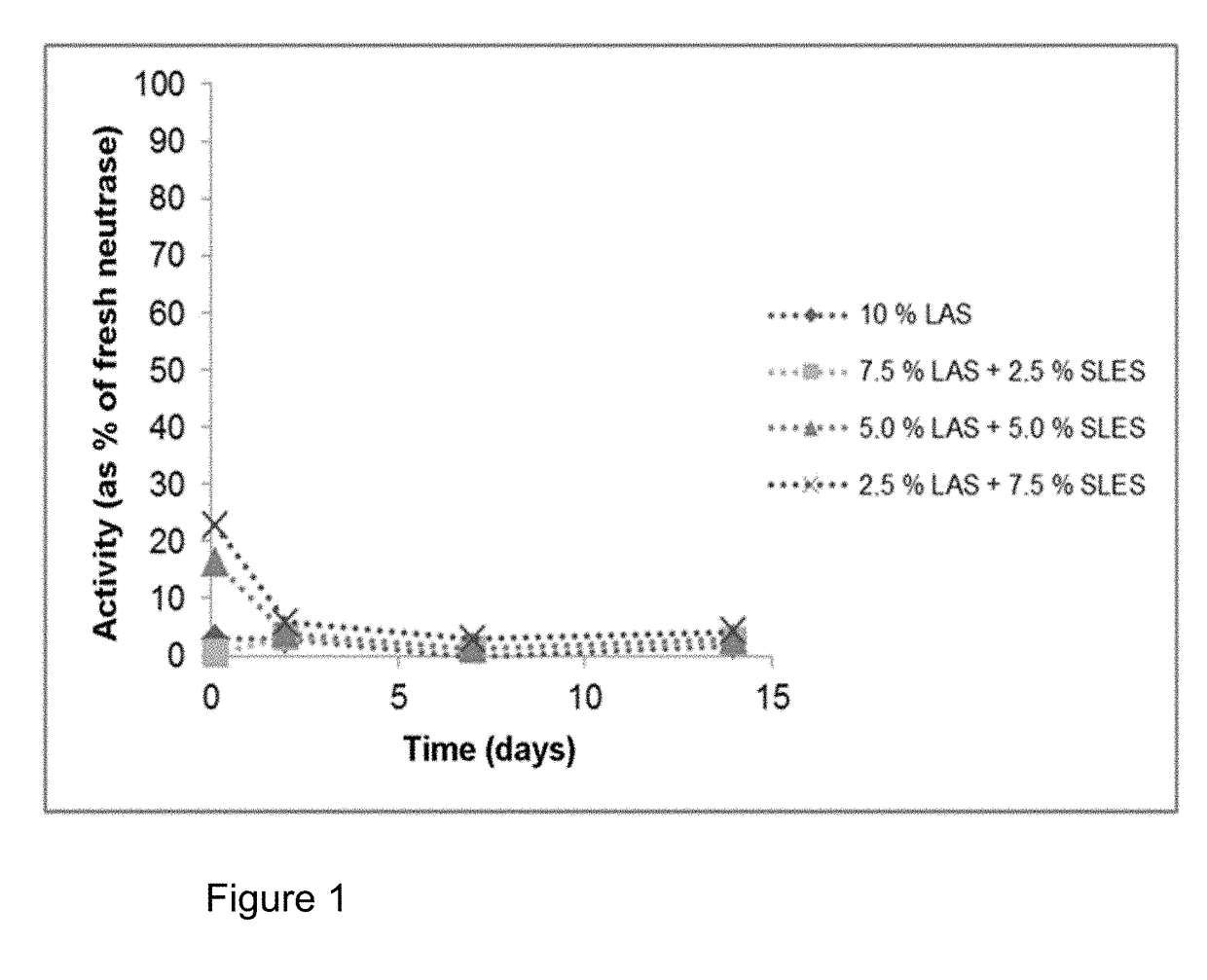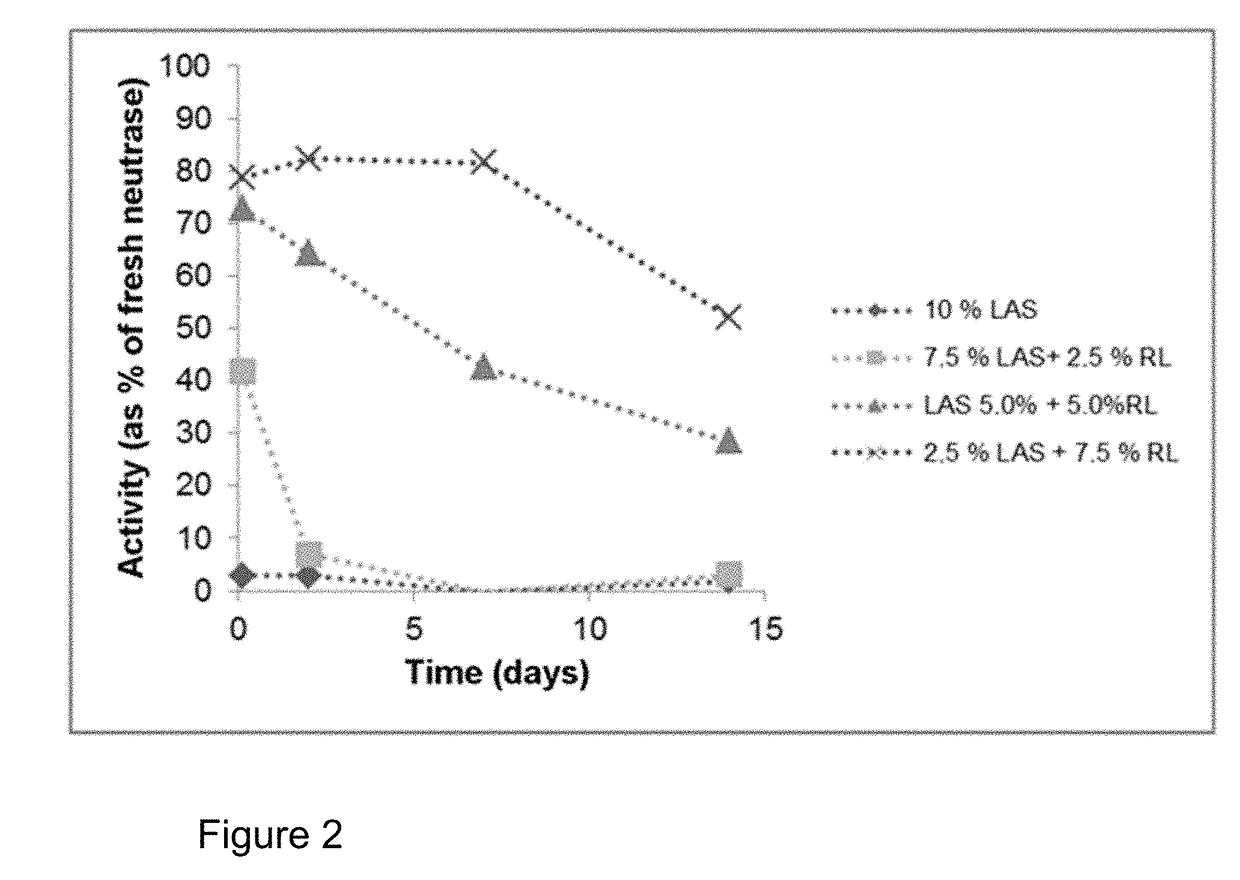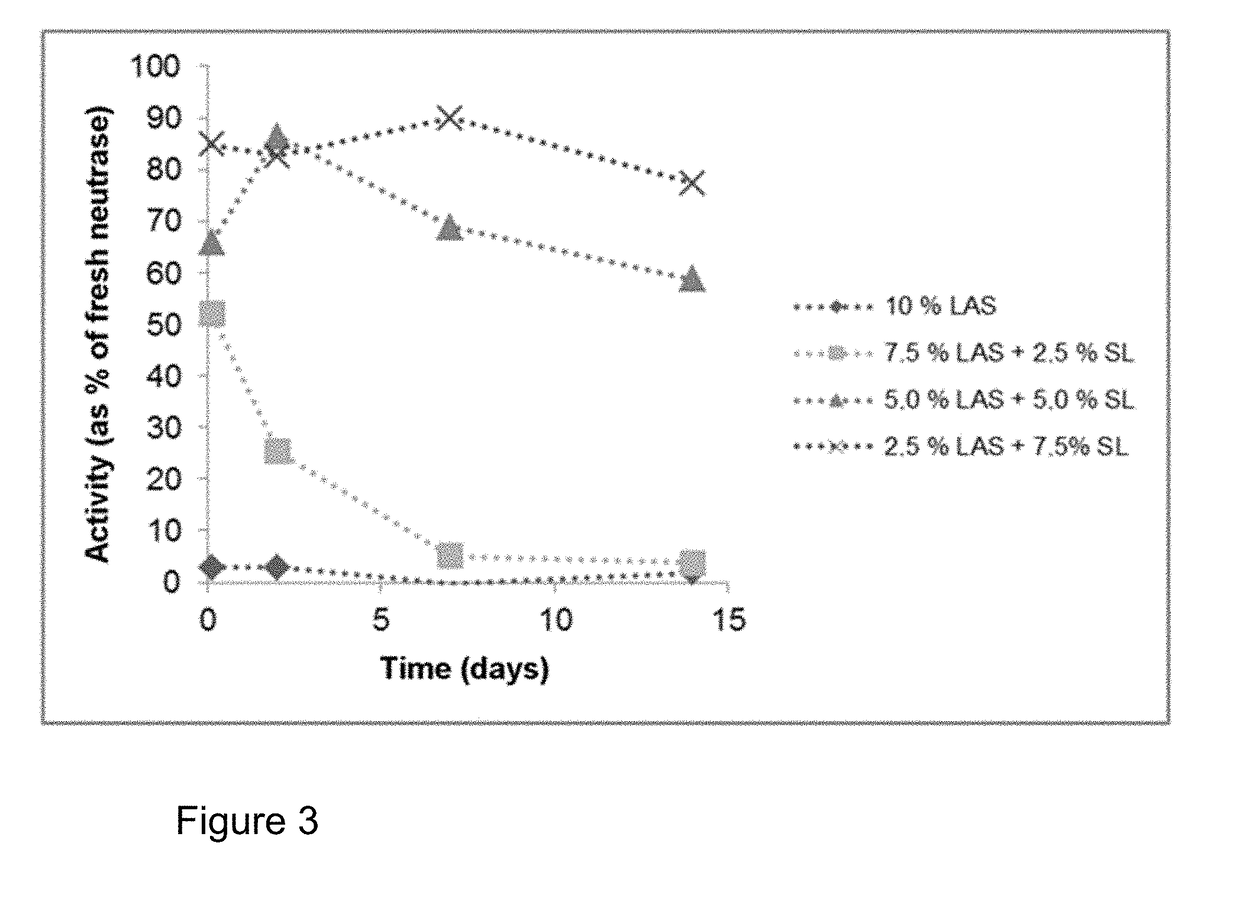Composition containing peptidase and biosurfactant
a technology of biosurfactant and peptidase, which is applied in the direction of surface-active detergent compositions, non-ionic surface active compounds, detergent compositions, etc., can solve the problems of decreased specific activity, achieve improved cleaning performance, reduce the amount of protease inhibitors, and increase the stability of enzymes during the washing process
- Summary
- Abstract
- Description
- Claims
- Application Information
AI Technical Summary
Benefits of technology
Problems solved by technology
Method used
Image
Examples
example 1
n of the Storage Stability of a Protease in Linear Alkylbenzenesulphonate (LAS), Mixtures of LAS with Sodium Lauryl Ether Sulphate (SLES), Mixtures of LAS with Rhamnolipid and Mixtures of LAS with Sophorolipid
[0129]The investigations should show the stabilising effect of SLES, rhamnolipid and sophorolipid on the proteases Neutrase and Alcalase in the presence of LAS. For investigations of the storage stability, surfactant mixtures were prepared in a 0.1M triethanolamine buffer (TEA) pH=8. The protease inhibitors propane-1,2-diol and boric acid were also added. The mixtures were adjusted to pH=8 by adding acid or base as needed. Proteases from liquid preparations were added to the relevant mixtures, mixed and the mixtures stored at 30° C. (cf. Table 1 and 2). The proteases were the products Neutrase® 0.8 L and Alcalase® 2.4 L FG (a subtilisin). Samples were taken at various timepoints from these compositions and diluted 100-fold with 0.1M phosphate buffer, pH=7. 100 μl of each of the...
example 2
Enzyme Stability in the Absence of a Protease Inhibitor
[0133]The storage stability tests and activity measurements were carried out analogously to Example 1. Additional compositions were made up in which the protease inhibitors propane-1,2-diol and boric acid were not added.
TABLE 3Compositions comprising LAS with and without variousstabilising surfactants, polyol, inhibitor and Alcalase ®2.4 L FG. Data in % by weight of the proportions in 0.1MTEA buffer. The pH of the compositions was adjusted to pH = 8.Composition3.13.23.33.4Linear10102.52.5alkylbenzenesulphonate(Marlon ARL, Sassol)Rhamnolipid or——7.57.5SophorolipidPropane-1,2-diol2.1—2.1—Boric acid1.6—1.6—Neolone PE0.40.40.40.4Alcalase ® 2.4 L FG0.10.10.10.1
example 3
ormulations
[0134]3.1 Powder Detergent 1
Sophorolipid:12.0Linear sodium alkylbenzenesulphonate5.3%Fatty alcohol ethoxylate C12-18 (7 EO)2.0%Sodium salts of fatty acids2.1%Antifoam DC2-4248S5.0%Zeolite 4A36.3%Sodium carbonate14.9%Sodium salt of acrylic-maleic acid3.1%copolymer (Sokalan CP5)Sodium silicate3.8%Carboxymethylcellulose1.5%Dequest 2066 (Phosphonate)3.6%Optical brighteners0.3%Protease (Savinase 8.0)0.5%Sodium perborate monohydrate1.0%Sodium sulphateRemainder
[0135]3.2 Powder Detergent 2
Rhamnolipid12.0Linear sodium alkylbenzenesulphonate5.3%Fatty alcohol ethoxylate C12-C18 (7 EO)2.0%Sodium salts of fatty acids2.1%Antifoam DC2-4248S5.0%Zeolite 4A36.3%Sodium carbonate14.9%Sodium salt of acrylic-maleic acid3.1%copolymer (Sokalan CP5)Sodium silicate3.8%Carboxymethylcellulose1.5%Dequest 2066 (Phosphonate)3.6%Optical brighteners0.3%Protease (Savinase 8.0)0.5%Sodium perborate monohydrate1.0%Sodium sulphateRemainder
[0136]3.3. Liquid Detergent 1
Sophorolipid6.0%Linear sodium alkylbenzene...
PUM
| Property | Measurement | Unit |
|---|---|---|
| pressure | aaaaa | aaaaa |
| temperature | aaaaa | aaaaa |
| pH | aaaaa | aaaaa |
Abstract
Description
Claims
Application Information
 Login to View More
Login to View More - R&D
- Intellectual Property
- Life Sciences
- Materials
- Tech Scout
- Unparalleled Data Quality
- Higher Quality Content
- 60% Fewer Hallucinations
Browse by: Latest US Patents, China's latest patents, Technical Efficacy Thesaurus, Application Domain, Technology Topic, Popular Technical Reports.
© 2025 PatSnap. All rights reserved.Legal|Privacy policy|Modern Slavery Act Transparency Statement|Sitemap|About US| Contact US: help@patsnap.com



